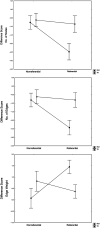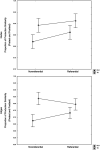Lexical-Semantic Cues Induce Sound Pattern Stability in Children With Developmental Language Disorder
- PMID: 33253605
- PMCID: PMC8608175
- DOI: 10.1044/2020_JSLHR-20-00244
Lexical-Semantic Cues Induce Sound Pattern Stability in Children With Developmental Language Disorder
Abstract
Purpose When learning novel word forms, preschoolers with developmental language disorder (DLD; also known as specific language impairment) produce speech targets inaccurately and with a high degree of intraword variability. The aim of the current study is to specify whether and how layering lexical-semantic information onto novel phonological strings would induce increased organization of sound production patterns. Method Twenty-one preschoolers with DLD and 21 peers with typical language (ranging in age from 4;1 to 5;11 [years;months]) imitated multiple renditions of novel words, half with (i.e., words) and half without (i.e., nonwords) a linked visual referent. Methods from network science were used to assess the stability and patterning of syllable sequences. Sound accuracy was also measured. Results Children with DLD were less accurate and more variable than their typical peers. However, once word forms were associated with a visual referent, network stability, but not accuracy, improved for children with DLD. Conclusions Children with DLD showed significant word form deficits as they acquired novel words and nonwords. The inclusion of a meaningful referent resulted in increased sound sequence stability, suggesting that lexical-semantic information provides a bootstrap for phonological organization in children with DLD.
Figures





Similar articles
-
A longitudinal study of the phonological organisation of novel word forms in children with developmental language disorder.Int J Speech Lang Pathol. 2022 Apr;24(2):212-223. doi: 10.1080/17549507.2021.1975816. Epub 2021 Sep 26. Int J Speech Lang Pathol. 2022. PMID: 34565237 Free PMC article.
-
Phonological and Articulatory Deficits in the Production of Novel Signs in Children With Developmental Language Disorder.J Speech Lang Hear Res. 2023 Mar 7;66(3):1051-1067. doi: 10.1044/2022_JSLHR-22-00434. Epub 2023 Feb 16. J Speech Lang Hear Res. 2023. PMID: 36795546 Free PMC article.
-
Speech sound development of young Dutch children with a developmental language disorder: A complex matter.Int J Lang Commun Disord. 2024 Nov-Dec;59(6):2706-2722. doi: 10.1111/1460-6984.13109. Epub 2024 Sep 4. Int J Lang Commun Disord. 2024. PMID: 39230308
-
An Application of Network Science to Phonological Sequence Learning in Children With Developmental Language Disorder.J Speech Lang Hear Res. 2018 Sep 19;61(9):2275-2291. doi: 10.1044/2018_JSLHR-L-18-0036. J Speech Lang Hear Res. 2018. PMID: 30167667 Free PMC article.
-
The evaluation of word-learning abilities in people with developmental language disorder: a scoping review.Int J Lang Commun Disord. 2019 Sep;54(5):742-755. doi: 10.1111/1460-6984.12490. Epub 2019 Jul 5. Int J Lang Commun Disord. 2019. PMID: 31276299
Cited by
-
Word Learning by Preschool-Age Children With Developmental Language Disorder: Impaired Encoding and Robust Consolidation During Slow Mapping.J Speech Lang Hear Res. 2021 Nov 8;64(11):4250-4270. doi: 10.1044/2021_JSLHR-21-00046. Epub 2021 Oct 11. J Speech Lang Hear Res. 2021. PMID: 34633854 Free PMC article.
-
Children With Developmental Language Disorder Show Deficits in the Production of Musical Rhythmic Groupings.J Speech Lang Hear Res. 2023 Nov 9;66(11):4481-4496. doi: 10.1044/2023_JSLHR-23-00197. Epub 2023 Sep 25. J Speech Lang Hear Res. 2023. PMID: 37748025 Free PMC article.
-
Touch to learn: Multisensory input supports word learning and processing.Dev Sci. 2024 Jan;27(1):e13419. doi: 10.1111/desc.13419. Epub 2023 Jun 8. Dev Sci. 2024. PMID: 37291692 Free PMC article.
-
A longitudinal study of the phonological organisation of novel word forms in children with developmental language disorder.Int J Speech Lang Pathol. 2022 Apr;24(2):212-223. doi: 10.1080/17549507.2021.1975816. Epub 2021 Sep 26. Int J Speech Lang Pathol. 2022. PMID: 34565237 Free PMC article.
-
The phonological congruency modulated long-term form priming of Chinese characters.Mem Cognit. 2024 Feb;52(2):312-333. doi: 10.3758/s13421-023-01462-y. Epub 2023 Oct 2. Mem Cognit. 2024. PMID: 37782444
References
-
- Alt, M. , Plante, E. , & Creusere, M. (2004). Semantic features in fast-mapping: Performance of preschoolers with specific language impairment versus preschoolers with normal language. Journal of Speech, Language, and Hearing Research, 47(2), 407–420. https://doi.org/10.1044/1092-4388(2004/033) - PubMed
-
- Baese-Berk, M. , & Goldrick, M. (2009). Mechanisms of interaction in speech production. Language and Cognitive Processes, 24(4), 527–554. https://doi.org/10.1080/01690960802299378 - PMC - PubMed
-
- Bankson, N. W. , & Bernthal, J. E. (1990). Bankson–Bernthal Test of Phonology. Riverside Publishing.
-
- Beckage, N. , Smith, L. B. , & Hills, T. T. (2011). Small worlds and semantic network growth in typical and late talkers. PLOS ONE, 6(5), Article e19348. https://doi.org/10.1371/journal.pone.0019348 - PMC - PubMed
-
- Benham, S. , Goffman, L. , & Schweickert, R. (2018). An application of network science to phonological sequence learning in children with developmental language disorder. Journal of Speech, Language, and Hearing Research, 61(9), 2275–2291. https://doi.org/10.1044/2018_JSLHR-L-18-0036 - PMC - PubMed
Publication types
MeSH terms
Grants and funding
LinkOut - more resources
Full Text Sources
Miscellaneous

